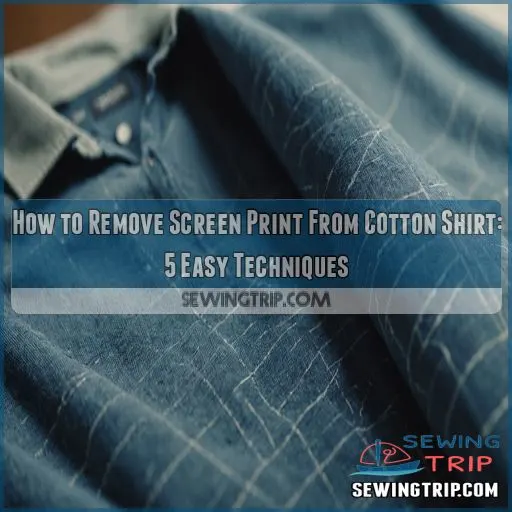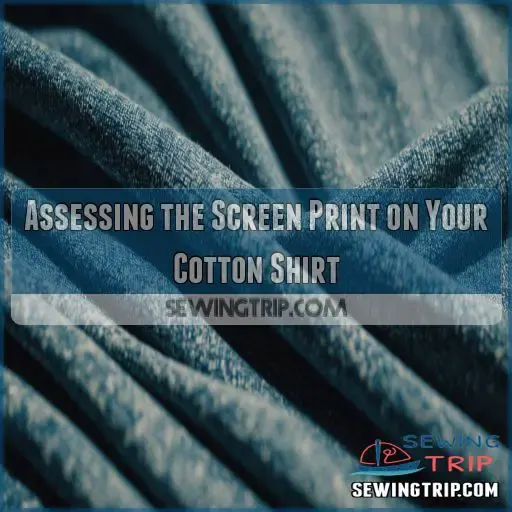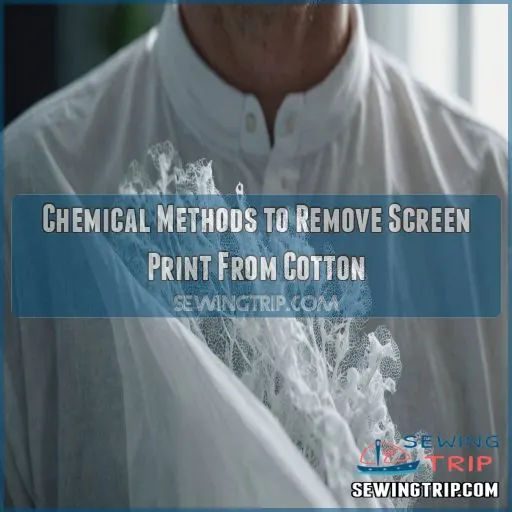This site is supported by our readers. We may earn a commission, at no cost to you, if you purchase through links.
 Removing a screen print from your cotton shirt doesn’t have to be a nightmare.
Removing a screen print from your cotton shirt doesn’t have to be a nightmare.
Start by assessing the print – is it thick and rubbery or smooth and faded?
Gather your tools – you’ll need acetone, rubbing alcohol, and an old toothbrush.
Work in a well-ventilated area and protect your surfaces.
Let the natural light guide you as you work.
For stubborn prints, try the iron-and-peel method or a sugar scrub.
Just be gentle and patient – you don’t want to damage that precious cotton.
Once the ink’s gone, give your shirt a good cold-water rinse and air dry it in the sun.
Your cotton tee will be as good as new, ready for its next adventure.
Table Of Contents
- Key Takeaways
- Assessing the Screen Print on Your Cotton Shirt
- Preparing Your Workspace for Screen Print Removal
- Chemical Methods to Remove Screen Print From Cotton
- Non-Chemical Techniques for Screen Print Removal
- Washing and Rinsing to Remove Screen Print Residue
- Aftercare and Fabric Restoration Post-Print Removal
- Frequently Asked Questions (FAQs)
- Conclusion
Key Takeaways
- Be a "detective" before starting: Assess the screen print on your shirt—know the ink type, the print’s age, and the fabric’s sensitivity. It’s like knowing your opponent before a chess match, which sets you up for success.
- Gather your gear: You’ll need acetone, rubbing alcohol, an old toothbrush, and a breezy workspace. Don’t forget to wear gloves and goggles, like a scientist preparing for a grand experiment.
- Chemical and non-chemical methods: Acetone, nail polish remover, and rubbing alcohol are your chemical allies. For a gentler approach, try the iron-and-peel method or a sugar scrub—less edgy, more like a spa day.
- Post-removal TLC: Once that pesky print is gone, treat your shirt with care. A fabric softener or vinegar rinse will make it as soft as a cloud, ready for its next adventure. Let it air dry in the sun, because like a good wine, some things just take time.
Assessing the Screen Print on Your Cotton Shirt
Before you tackle removing a screen print from your cotton shirt, take a moment to assess the situation, just like you’d evaluate the lineup of condiments at a burger bar (no one wants ketchup when they mean to grab relish).
It’s important to identify the ink type, check if the print’s aging worse than a 90’s haircut, and make sure your fabric can handle the process.
Identifying the Type of Screen Printing Ink Used
Before tackling that stubborn design, get cozy with the ink’s personality. Feel its texture—plastisol ink is thick and rubbery, while water-based is smooth.
Knowing what you’re up against gives you an edge in screen print removal. It’s like meeting your opponent before a chess match!
Peek at the print location and color on your cotton fabric. The thickness hints at durability.
Examining the Age and Condition of the Print
As you check the screen print on your cotton shirt, you’d notice that ink cracking, print fading, or color bleeding can tell tales of its age and condition.
Print aging is similar to wine aging, but not quite as graceful.
Understanding these factors helps you understand the print’s adhesion, guiding you in choosing the best approach for design removal without compromising fabric integrity.
Evaluating the Fabric’s Condition and Sensitivity
Before tackling screen print removal, closely examine your cotton fabric.
Consider the fabric’s age, weave, and colorfastness – these factors will guide your approach.
Delicate or vintage fabrics may require gentler, non-chemical methods to avoid damage.
Polyester blends, on the other hand, can often withstand stronger solvent-based removers.
Assess the fabric’s sensitivity to make sure you get a successful, safe screen print removal.
Determining the Size and Complexity of the Design
Now that you’ve sized up the fabric, take a closer look at the screen print itself.
Is it a dainty monogram or a giant logo?
Larger, complex designs require more patience and finesse to remove.
Roll up your sleeves; it’s a time commitment!
Choose removal tools wisely based on print detail and fabric type to make this mission a successful endeavor.
Preparing Your Workspace for Screen Print Removal
Before you begin removing screen print from your cotton shirt, make sure your workspace is ready for action to avoid creating a bigger mess.
Gather your tools and work in a breezy spot.
Cover those precious surfaces—as they say, better safe than scrubbing!
Gathering Necessary Tools and Materials
Grab your toolkit: acetone or rubbing alcohol, a polyester-safe screen print remover (for the brave or budget-conscious), and a handy cold-water rinse setup.
Don’t forget an old toothbrush for scrubbing.
Having these tools on standby will make removing screen prints from your cotton shirt a breeze. It’s like magic, but with fewer rabbits and more planning!
Setting Up a Well-ventilated Area
Good ventilation is really important when removing screen prints.
Set up your workspace in a well-ventilated area, like near an open window or with a fan running.
This helps disperse any fumes from chemicals used in the process.
Don your safety gear, such as gloves and goggles, to protect yourself.
Make sure the space is well-lit for detailed work.
Protecting Surfaces From Potential Stains or Damage
When setting up your workspace, you’ll want to put down surface covers to prevent accidental spills.
Old newspapers or plastic sheets work like a charm!
Trust me, nothing screams disaster like acetone stains on your grandma’s heirloom table.
Keep some adhesive remover or a commercial product handy for any surprise mishaps.
Safety and prep go together like peas in a pod!
Ensuring Proper Lighting for Detailed Work
Good lighting is really important when removing screen print from your cotton shirt. Avoid eye strain and make sure every corner is visible by:
- Using natural light whenever possible.
- Investing in a reliable work lamp.
Controlling shadows for clear visibility.
Keeping a magnifying glass handy for detailed work.
Brightening your space to banish stubborn logo residue.
Chemical Methods to Remove Screen Print From Cotton
Removing screen print from a cotton shirt using chemicals is like breaking up with a stubborn ex—it requires patience and the right tools.
Removing screen print from a cotton shirt can be done using chemicals.
You’ve got options like acetone, nail polish remover, and rubbing alcohol to make that design a distant memory.
Using Acetone for Effective Ink Dissolution
One surefire way to dissolve stubborn screen printing ink on your cotton shirt is to reach for the powerful solvent, acetone.
Acetone can be harsh on fabrics, so test it on a small, inconspicuous area first.
Apply it gently with a cotton ball, and rinse thoroughly to prevent any damage.
Applying Nail Polish Remover as a Gentler Alternative
Nail polish remover is a more forgiving option for delicate or older prints on cotton shirts than acetone.
Think of it as acetone’s kinder cousin!
To use it safely:
- Dab a small amount onto the print.
- Gently rub with a cloth.
- Rinse thoroughly.
Voila, you’ve got a fresh canvas!
Utilizing Rubbing Alcohol for Ink Breakdown
Got a screen print you don’t love? Using rubbing alcohol is your ticket to freedom! It helps break down ink, leaving your cotton shirt looking fresh. Just make sure it’s 70% concentration for best results.
Know your fabric compatibility and test a hidden spot first. If it acts like a gremlin with water, find alternative solvents.
Employing Specialized Screen Print Removal Products
After checking out rubbing alcohol, now take a peek at specialized screen print removal products designed just for the job, like plastisol remover plastisol remover. These can make ink vanish like a magic trick:
Specialized screen print removal products can be effective, but follow these tips for success: check out removal products for polyester
- Check product reviews for effectiveness.
- Compare costs—saving bucks matters!
- Look for brand recommendations.
- Follow application tips carefully.
Safety precautions, folks—no shortcuts!
Safely Handling and Storing Chemical Solvents
Safety should be your top priority when handling chemical solvents.
Make sure you have proper ventilation, wear protective gloves and goggles, and store solvents in tightly sealed containers away from heat sources.
Responsible disposal of used solvents is essential, following local regulations.
With a little caution, you can tackle that stubborn screen print without a hitch!
Non-Chemical Techniques for Screen Print Removal
Need to get rid of that old screen print on your favorite cotton shirt without using harsh chemicals?
Don’t worry, we’ve got some easy and gentle methods for you—your shirt will be as fresh as your mom’s latest fashion advice!
Implementing the Iron and Peel Method
Iron away that pesky print with the "Iron and Peel" method! Set the iron to a medium temperature, place a paper bag over the design, and iron gently. Watch the ink adhesion lessen as you peel the paper off, like peeling a sticker. Maintain fabric protection to avoid burns, but relish the control!
- Achieve print-free perfection!
- Protect cherished memories.
- Create fashion freedom!
Using Salt and Vinegar Solution for Gentle Removal
Iron and peel not your cup of tea? Try the salt and vinegar solution! Sprinkle salt and douse vinegar onto the print, as if you’re seasoning steak. But don’t skimp on vinegar concentration—strength matters! Let it pre-soak for 15 minutes. Watch ink type vanish while maintaining fabric sensitivity. Voilà, your shirt’s got freedom!
| Step | Action |
|---|---|
| 1 | Generously sprinkle salt over the print |
| 2 | Pour vinegar to soak the area |
| 3 | Wait for 15 minutes before rinsing |
Applying a Sugar Scrub to Lift Fresh Prints
If you’ve got a fresh screen print that’s just not doing it for you anymore, try using a sugar scrub to lift it off.
Just mix up some granulated sugar with a bit of water to create a gritty paste, then gently scrub the print using circular motions.
The abrasiveness of the sugar will help break down the ink without damaging the fabric.
Be patient and keep scrubbing until the design starts to fade – it’s a simple, chemical-free way to refresh your cotton tee.
Freezing the Print to Make It Brittle
Let’s try freezing that pesky print! Just pop your shirt in the freezer for a couple of hours.
When fabric and ink get frosty, the print becomes brittle—like a cookie left out too long.
Gently peel off the brittle bits without damaging the fabric.
Don’t expect miracles, though; this works best on recently printed designs looking for an escape!
Employing Adhesive Tape for Residue Removal
Grabbing a trusty roll of tape, get started on the sticky business of residue removal.
Opt for stronger tape types; they latch onto the ink like a clingy friend.
Peel off slowly, savoring the satisfying sensation as the sticky residue meets its match.
It’s like a tug-of-war with your fabric—minus the damage.
Embrace patience; you’ll emerge victorious!
Washing and Rinsing to Remove Screen Print Residue
When you’re trying to banish a stubborn screen print from your favorite cotton T-shirt, effective washing and rinsing can be your secret weapon.
With some simple tricks like using cold water or sneaking vinegar into the wash, you’ll be winning the war against unwanted ink stains.
Pre-treating the Affected Area Before Washing
Before tossing your cotton tee in the wash, give the screen-printed area a quick pre-treatment.
Perform a spot test on an inconspicuous section to make sure the removal method won’t damage the fabric.
This will help you gauge the ink type and determine the safest approach for your delicate cotton.
A little prep work goes a long way!
Using Cold Water Rinse for Fresh Prints
After pre-treating, pop your cotton shirt in a cold water wash. Fresh prints don’t stand a chance—no need for a sauna session!
Cold water’s your ally in print fading, as it helps lift that pesky ink off without causing fabric damage.
Whether you’re hand washing or using the washing machine, keep it chilly and watch the prints fade away like magic!
Incorporating Vinegar in the Wash Cycle
Vinegar’s not just for dressing salads—it can help in screen print removal too! Add a splash during the wash cycle for a gentle touch:
- Acts as a natural fabric softener
- Helps prevent color fading
- No harsh chemicals involved
- Mixes well with other stain removal techniques
- Keeps your cotton shirt fresh as a daisy!
Who knew vinegar had more tricks up its sleeve?
Applying Stain Removers for Stubborn Residues
Now, let’s tackle those stubborn residues with stain removers. Choose one compatible with your fabric—nothing’s worse than an unwanted bleaching incident. Dab a bit on a hidden spot first to test for any unwanted reactions.
For removal, gently rub the remover into the residue, working in small circles.
Remember, safety first: wear gloves and keep the room ventilated. Voilà, you’re one step closer to a pristine shirt!
Proper Drying Techniques to Prevent Setting
Once you’ve removed the stubborn screen print residue, it’s really important to dry the fabric properly to prevent the ink from setting back in.
Air drying in the sun is best, as the heat and airflow will help lift any remaining traces.
Avoid tossing the shirt in the dryer, as the high heat can actually bake the ink right back into the fibers.
Take your time and let that cotton breathe!
Aftercare and Fabric Restoration Post-Print Removal
Removing screen prints from your cotton shirt is only half the battle; now it’s time to pamper your fabric and get it back to its soft and comfy state.
Check for leftover ink, mend any color mishaps, and treat your shirt to a spa day with fabric conditioner, because even clothes deserve a little relaxation!
Inspecting the Fabric for Any Remaining Ink
Take a close look at your shirt, just like a detective on a mission.
Examine the fabric’s condition and the ink color in various lighting.
Pay attention to the print location for any sneaky residue.
Look out for visible damage.
Sometimes, ink is like a stubborn guest that overstays its welcome, so inspect carefully to catch every last bit.
Treating Any Discoloration or Fabric Damage
When working on fabric repair, fear not, a little color restoration can perform miracles!
Did the screen print removal leave stains? Try mixing vinegar and baking soda for stain removal – a classic trick!
Wondering about damage prevention? Babysitting your fabric like your favorite flannel shirt can go a long way. Remember, your shirt’s fibers deserve love, too!
Softening the Cotton Fabric After Chemical Exposure
After using harsh chemicals to remove the screen print, your cotton fabric may feel stiff and dry.
Restore softness by adding a fabric softener to the rinse cycle or soaking the item in a vinegar solution.
This will help rehydrate the fibers and leave your shirt feeling soft and supple once more.
Ironing or Steaming to Restore Fabric Texture
Reviving fabric texture through ironing or steaming feels like giving your shirt a comforting, warm hug. Just be careful not to leave it with heat damage!
Consider these tips:
- Use appropriate steam settings.
- Avoid direct heat on delicate fibers.
- Iron inside-out for protection.
Let your shirt cool before handling.
Embrace occasional wrinkles for character!
Applying Fabric Conditioner for Enhanced Softness
With your fabric now ironed or steamed, let’s focus on making it feel as soft as a cloud. A fabric conditioner works wonders here. Just choose from top brands like Downy or Gain, apply it during the final rinse, and notice the difference. If conditioners aren’t your thing, try white vinegar as a softener alternative for a natural touch!
Fabric softeners can enhance the softness of your clothes and add a pleasant fragrance.
There are many different types of fabric softeners available, including liquid, sheets, and natural alternatives.
If you are looking for a specific benefit, you can choose a softener that is specifically formulated for that purpose.
| Benefit | Conditioner Type | Brand Suggestion |
|---|---|---|
| Enhanced softness | Liquid | Downy |
| Fragrance addition | Sheets | Snuggle |
| Natural alternative | Vinegar | Heinz |
| Sensitive skin formula | Hypoallergenic | Seventh Generation |
| Eco-friendly option | Plant-based | Method |
Frequently Asked Questions (FAQs)
Can you remove screen printing from cotton?
You can remove screen printing from a cotton shirt by using nail polish remover or acetone.
Simply dab the ink with a solvent-soaked cotton ball, and watch the design disappear, like magic.
Just don’t overdo it!
How do you remove a logo from a cotton shirt?
Grab some acetone or nail polish remover for that pesky logo.
Dab a cloth, gently rub the design, and watch it disappear like magic.
Remember, though, work in a well-ventilated area and wear gloves!
How to get screen print off a tee?
Banish that bothersome blot with a bit of baking soda and a splash of vinegar – a dynamic duo that’ll dissolve that design without damaging your duds.
Dab, dunk, and delight in a design-free delight!
Can screen printing be removed from colored cotton shirts?
Removing screen printing from colored cotton shirts can be as easy as pie! Try acetone or nail polish remover with gentle scrubbing. Though it’s not foolproof, these methods often do the trick. Just remember, patience is key!
What tools are needed for screen print removal?
Sometimes, life throws a curveball, and a screen print just doesn’t fit your style anymore.
You’ll need acetone or rubbing alcohol, a soft cloth, mild detergent, and your gentle scrubbing skills to regain control over your wardrobe.
How long does screen print removal take?
You’ve got a weekend warrior project on your hands! Screen print removal from a cotton shirt can take a few hours to a day, depending on the methods you use and the stubbornness of the design. This depends on the different removal methods you choose to try and how stubborn the design is.
Is it possible to completely restore fabric color?
Restoring fabric color after screen print removal can be tricky, but with the right approach, you can get close to the original shade. Consider ink composition and fabric type for effective removal.
Try a gentle bleach solution or oxalic acid – just be sure to test first on an inconspicuous area.
With some elbow grease, you can revive that tee.
Does screen print removal weaken the cotton fabric?
Removing screen print from cotton fabric doesn’t typically weaken it, unless you’re scrubbing like a bear on a beehive.
Gently use solvents like acetone or nail polish remover, and exercise a little patience for the best results.
Conclusion
Imagine 25% of your wardrobe experiencing a miraculous transformation, free from unwanted screen prints! It’s easier than you think to remove screen print from a cotton shirt.
Removing screen print from a cotton shirt can be done with a mix of easy-to-follow methods.
Just remember: patience is key, and protecting fabric is a must.
Whether you’re scrubbing with sugar or carefully applying acetone, you’re on your way to a fresh start—and your closet will thank you!












